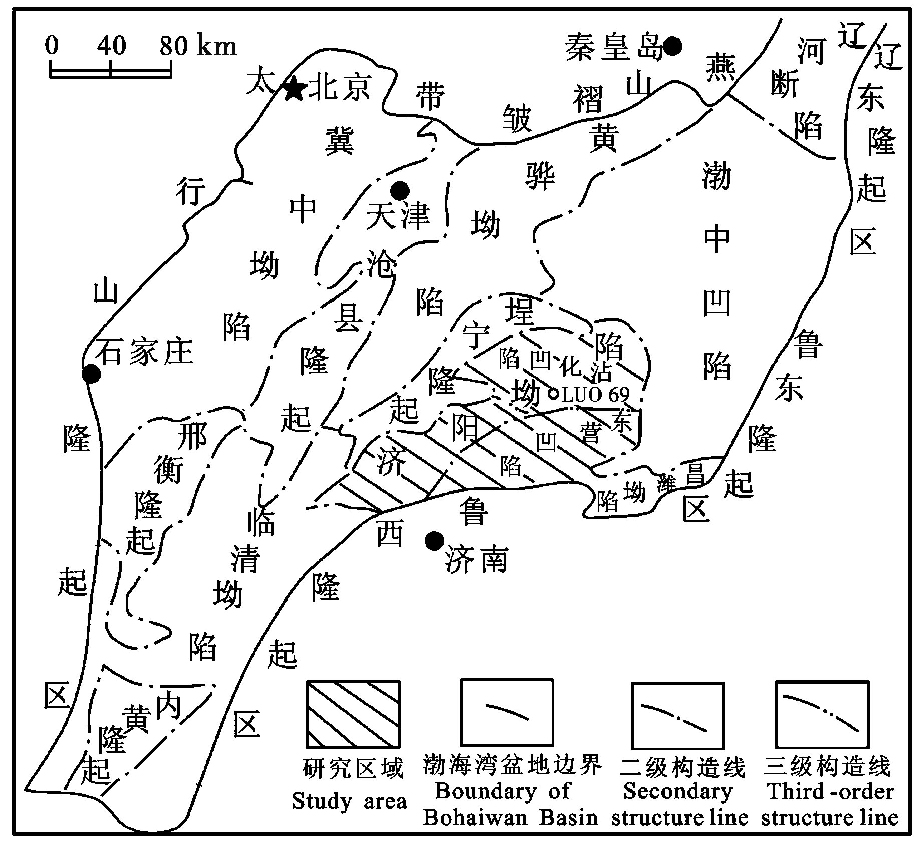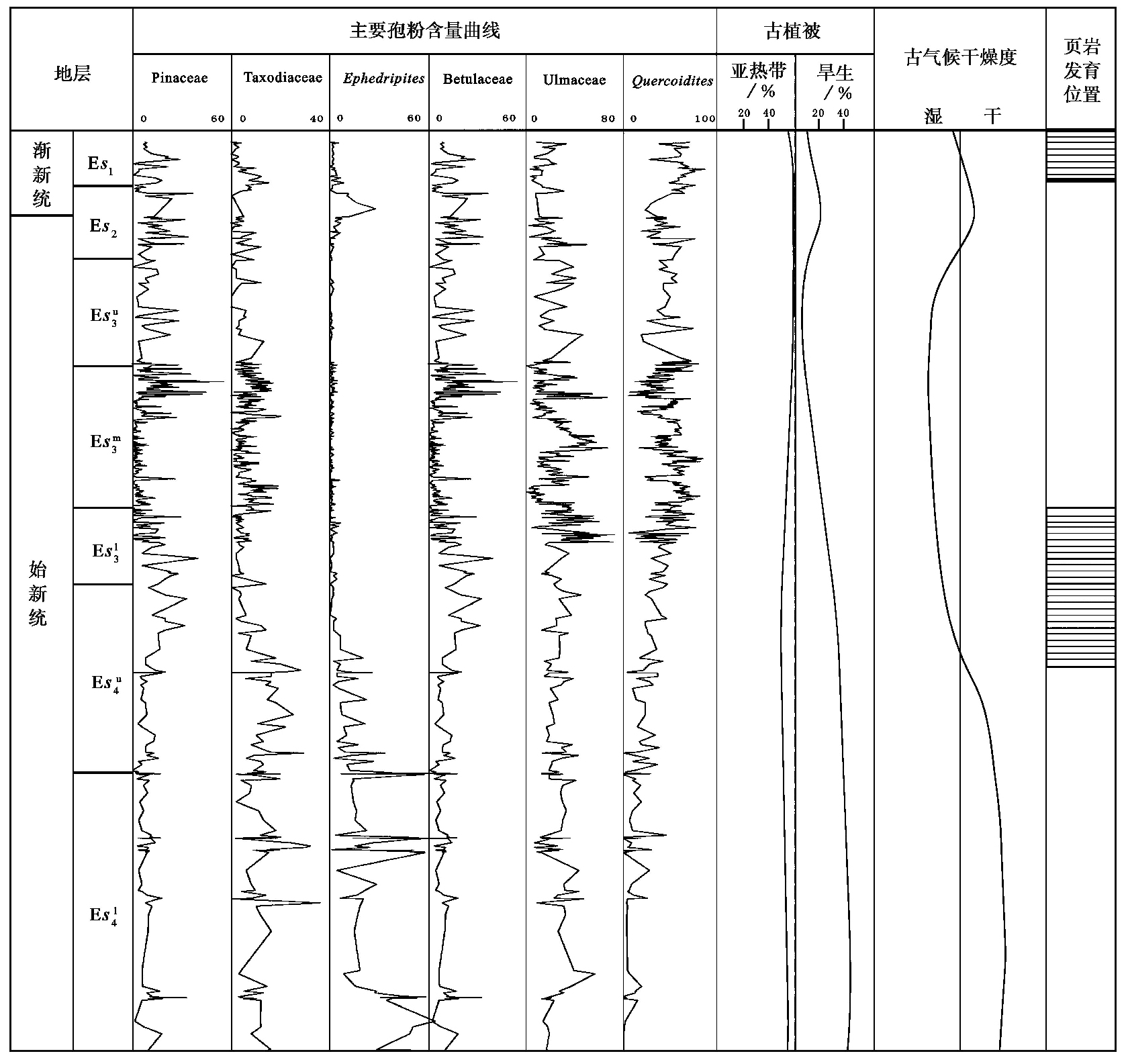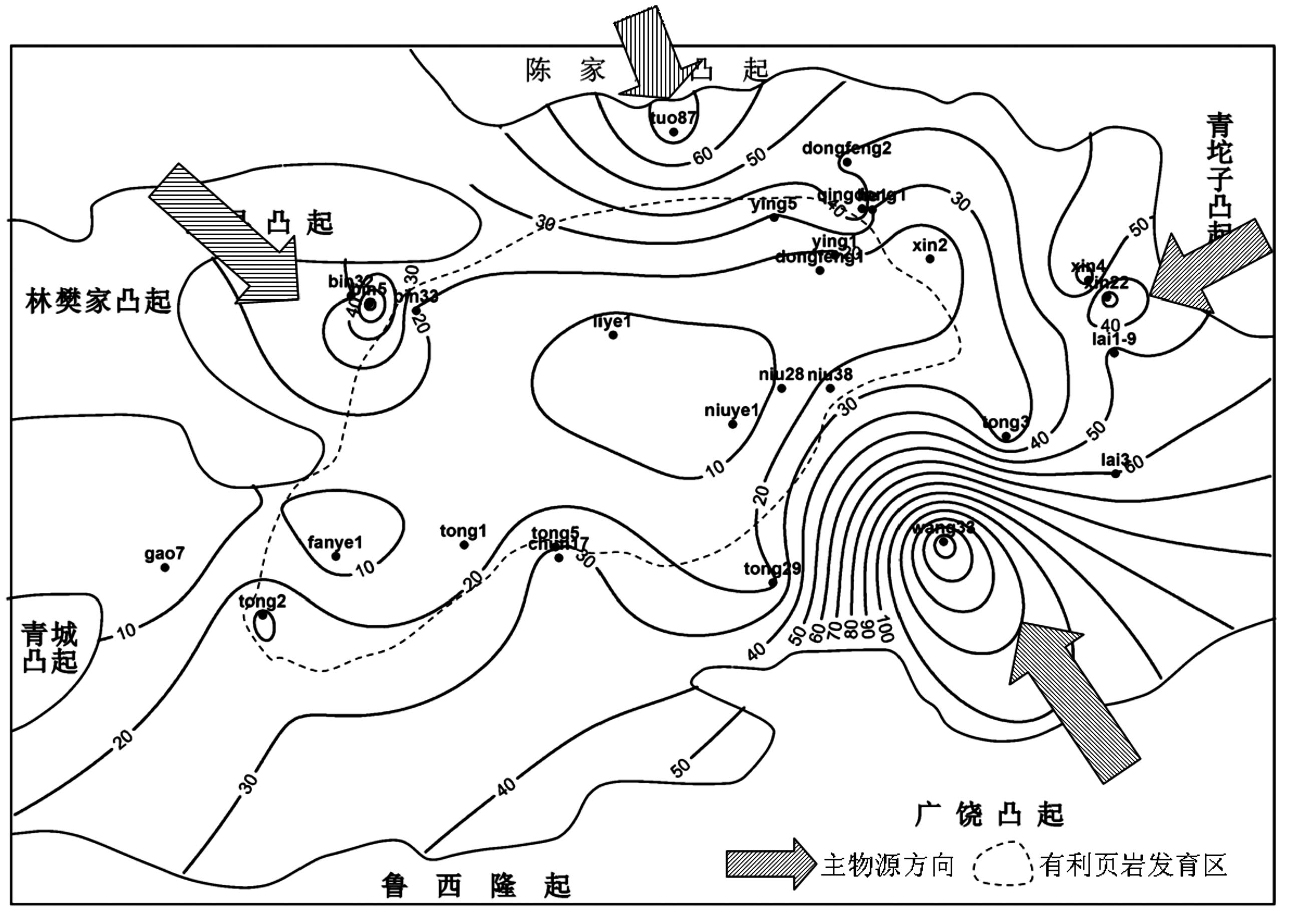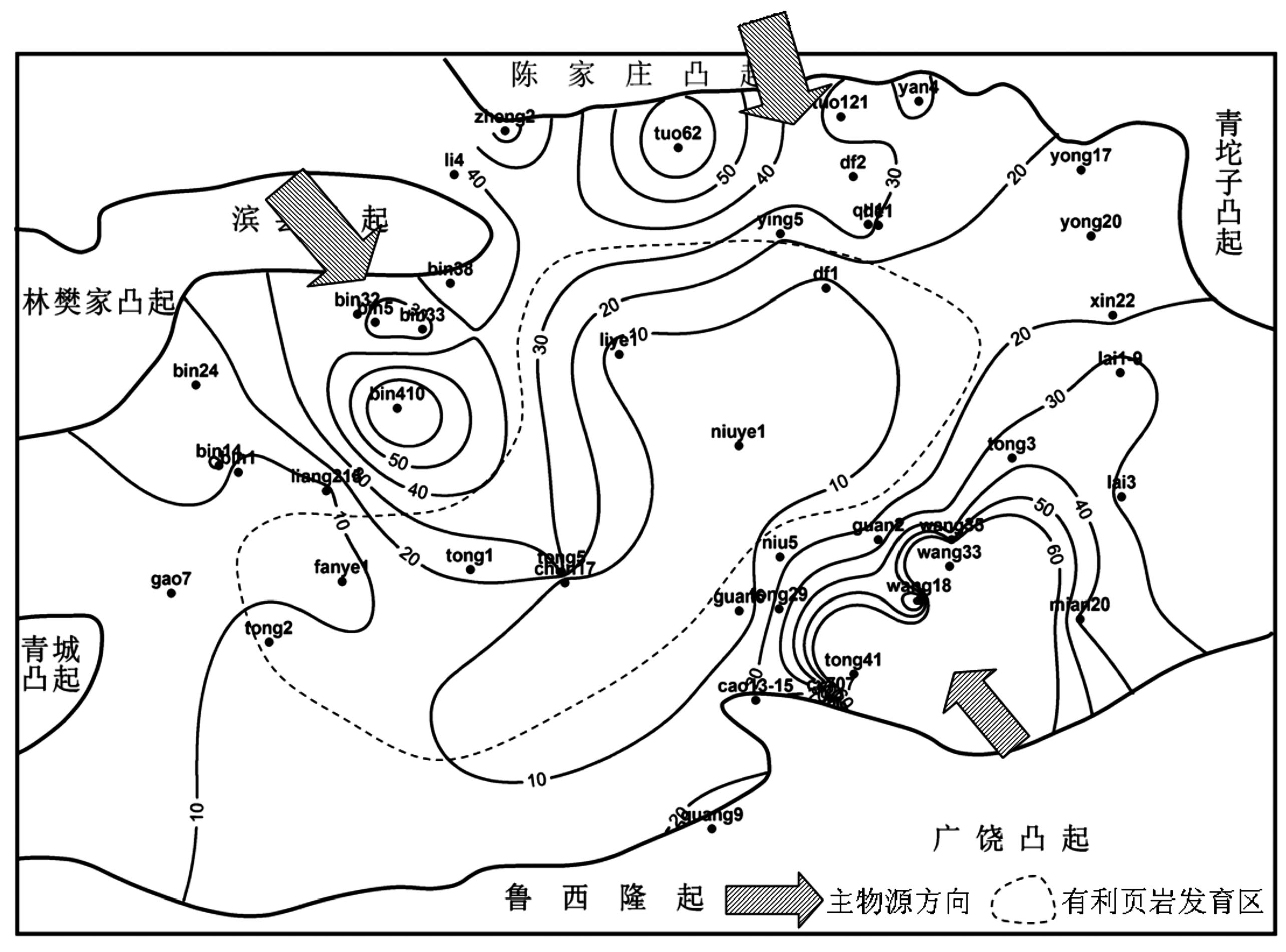随着非常规油气逐步成为重要勘探领域,页岩日益受到重视,但目前主要是依据其无机物质反映出来的物理特征,即利用岩性、 测井或地震等资料[1, 2],恢复沉积环境、 研究油气成藏等,而较少考虑页岩沉积时及成岩过程中的生物作用。生物是页岩的主要组成部分,是沉积和成岩的重要参与者。
页岩形成因素比较复杂,包括气候、 水深、 盐度、 湖流、 入注水流、 生物和生物化学作用等多个方面[3, 4]。对同一湖泊页岩的成因也存在争议,如开发程度高、 研究学者多的北美绿河页岩,一种观点认为是深水、 较淡时形成的[5],也有人认为是形成于大型干盐湖体系内的浅水但缺氧分层、 半咸水-咸水的碱性湖泊中[6],或者是有一定盐度和深度、 开阔的湖泊生物化学成因[7]。目前,湖水分层可能更利于形成页岩已得到很多专家学者认可[8, 9, 10]。但笔者认为,无论是何种因素,页岩形成至少有两个必要条件,一是沉积环境有韵律地变化,二是沉积后不能遭受破坏(包括水流、 生物的扰动等)[11, 12]。气候周期性变化就成为纹层形成的最广泛的控制因素[12, 13, 14],或者是最重要因素之一。孢粉的母体植物对气候较为敏感,气候直接影响页岩的形成,因此,孢粉与页岩存在一定关联。
1 研究区概况济阳坳陷位于渤海湾盆地东南部( 图1),东邻郯庐断裂,西北以大型基岩断裂与埕宁隆起相接,南邻鲁西隆起区,面积约为26000km2,是在华北地台基底上发育的中生代、 新生代断陷-坳陷叠合盆地[15]。

|
图 1 研究区构造位置图 Fig.1 Sketch map showing the tectonic location of the Jiyang Depression |
济阳坳陷古近系从下至上划分为3个组,分别为古新统-始新统的孔店组、 始新统-渐新统的沙河街组和渐新统的东营组。沙河街组自下而上进一步划分为四段(始新统,包括下亚段和上亚段,分别简称为沙四下Es4l和沙四上Es4u)、 三段(始新统,包括下亚段、 中亚段和上亚段,分别简称为沙三下Es3l、 沙三中Es3m和沙三上Es3u)、 二段(始新统-渐新统,简称为沙二段Es2)和一段(渐新统,简称为沙一段Es1)。根据钻井资料揭示,济阳坳陷古近系页岩层发育于沙四上、 沙三下和沙一段[16]。
沙四上页岩主要分布在东营凹陷和沾化凹陷[16],为咸水-半咸水湖相沉积,岩性以灰褐色钙质纹层泥页岩为主,厚度为250~300m; 沙三下泥页岩全区分布,为微咸水湖相沉积,岩性主要为油页岩、 钙质泥岩和灰色泥岩; 沙一段泥页岩全区分布,为咸水-半咸水湖相沉积,岩性为白云岩、 泥质白云岩、 油页岩、 钙质泥岩和暗色泥岩互层。
2 孢粉数据来源在济阳坳陷50余年勘探开发历程中,积累了大量孢粉化石资料,系统建立了古近纪孢粉组合[17, 18],本文研究以已有数据和结论为基础,并对新钻探井LUO 69井页岩进行了系统的孢粉分析。
LUO 69井是胜利油田在沾化凹陷钻探的一口针对页岩的重点探井,于2911 . 00~3140 . 75m连续取芯,进尺229 . 75m,芯长221 . 36m。在2930 . 00~3140 . 75m沙三下页岩段,笔者以约每米2个的密度采集了孢粉样品,共计411个,按照常规孢粉分析流程进行处理,每个试样至少鉴定4个盖片。在197个试样中见到孢粉化石,但总体丰度不高(只有5个试样孢粉化石粒数达到65粒以上,可以计算百分含量),共26科42属。无论是类型还是含量,亚热带份子都居首位,山毛榉科的Quercoidites (平均含量24.64 % )占优势,杉科的Taxodiaceaepollenites (17 . 72 % )次之,温带类型植物花粉主要有榆科的榆粉属Ulmipollenites(18 . 12 % )、 胡桃科的Momipites(4 . 72 % )及松科的Abietineaepollenites(3 . 72 % )和Pinuspolleni(3 . 00 % )等,旱生植物花粉Ephedripites(4 . 36 % )较少出现。
LUO 69井有机碳数据为胜利油田地质科学研究院石油地质中心测定,以大概每米1个的间距,共计232个数据。
3 古气候的孢粉响应特征前已述及,气候季节性变化是页岩纹层形成的主要因素,但并不是所有具备气候季节性变化的都能形成纹层,需要有特定气候。
依据孢粉化石、 微量元素、 岩性、 电性或地球化学、 有机元素等特征,很多学者都对济阳坳陷古近纪的气候变化特征进行过系统研究[17, 18, 19, 20, 21, 22, 23]。由于受成岩作用、 多物源等因素影响,岩石物性变化较为复杂,而孢粉沉积的稳定性不受成岩作用影响,可以相对准确、 相对系统恢复出济阳坳陷古近纪的气候变化。植物对气候的敏感性决定了不同气候带会生长不同植物群,因此,利用地层中植物体产生的孢粉组合特征恢复古气候以及环境,是目前最为直接和相对准确的方法,并被广泛应用[24, 25, 26, 27, 28, 29, 30, 31, 32, 33]。利用孢粉研究古气候,主要是根据其母体植物的生长环境,来恢复当时的气候特征。尽管沉积物中的孢粉化石多为异地沉积,但它们的母体植物一般分布于沉积区附近,其气候特征与沉积区应该一致。
济阳坳陷古近纪沙河街组沉积时期,亚热带植物有相当多含量[17, 18, 19, 20, 21],特别是中、 后期,以Quercoidites最多,Quercoidites是山毛榉科分子,与现生Quercus和Catanopsis的花粉相似,这种植物多分布于亚热带,因此,整个沙河街组沉积时期,本区属于亚热带无疑[21]。至于是南亚热带、 中亚热带还是北亚热带,根据现有孢粉资料、 植被恢复方法、 热带划分原则等均是很难具体确定的。
亚热带区,不但季节性变化明显,水体藻类也容易勃发,沉积后会形成大量有机质,这也是页岩组成的最重要物质基础[34, 35, 36, 37]。从这个角度来说,沙河街组沉积时期的气候有利于页岩形成。
笔者在对济阳坳陷古近系沙河街组已有孢粉资料重新整理的基础上,修订了古气候特征( 图2)[20, 21],可以发现,页岩发育层段均处在气候由干旱向潮湿转变的转换期,这反映了济阳坳陷古近系页岩形成时湖水分层是受温度和盐度双重控制; 而盐度也与气候有关[38, 39]。干旱时期,盐度较高,容易形成盐湖,但不利于藻类繁育,一般难以形成页岩,气候持续潮湿,降水量或入湖水量持续增加,水体变淡,尽管藻类丰富,但水体变淡,不利于湖水分层,一般也难以形成页岩。只有在气候由干旱向潮湿转变的转换期,藻类开始大量发育,湖水仍具一定盐度,多分层,利于页岩形成[34, 35, 36]。

|
图 2 济阳坳陷沙河街组古气候变化曲线与页岩发育 Fig.2 The variation curve of climate and shale distribution in Shahejie Formation of Jiyang Depression |
济阳坳陷沙四下沉积时期,孢粉属种较为单调,干旱型植物孢粉Ephedripites含量较高,此时,气候特别干旱,湖泊范围较小,藻类不发育,湖水盐度较高[40]; 进入沙四上沉积时期,Ephedripites仍有一定含量,Taxodiaceaepollenites、 Quercoidites等逐渐增多,气候开始向潮湿转变,但早期,气候延续了一定程度干旱,济阳坳陷局部沉积了泥岩夹膏盐,沙四上沉积后期,Ephedripites含量进一步降低,潮湿性孢粉类型发育,说明气候逐渐潮湿,藻类开始繁盛,导致页岩发育,这种情况一直延续到沙三下沉积时期[41],整个湖盆范围持续扩大,但水体仍有一定盐度,湖水分层较为明显。沙四上页岩的钙质层在局部发育颗石藻化石[42],沙三下颗石藻较少。
进入沙三中沉积时期,Quercoidites含量进一步增加,达到了沙河街组沉积时的高峰,Ephedripites含量极低,此时气候更加湿润,湖盆范围开始增大,水体变淡,分层不明显,同时,陆源输入增加,湖水动荡,这些因素都不利于页岩形成,而块状泥岩发育范围扩大,厚度增加。潮湿气候持续到沙二段沉积早期。
沙二段沉积后期,Ephedripites出现一个含量小高峰,表明气候又开始干旱,但这次干旱程度低,持续时间短,湖盆范围收缩较小,Ephedripites高含量分布只在部分钻孔出现,说明其只在湖盆周围水上斜坡有所发育。短暂干旱后,进入沙一段,气候由干旱开始逐渐转为潮湿,Quercoidites仍占据孢粉中的优势地位,又进入页岩发育期,此阶段最大特点是颗石藻发育,页岩的碳酸盐岩层基本上都是由颗石藻组成[42, 43]。东营组沉积开始,气候继续潮湿,榆科分子的含量已明显多于Quercoidites,气温变凉,页岩不再发育。
同理,在气候由潮湿转向干旱时,有机质仍发育且盐度增大,水体产生分层,也应该发育页岩。但对于济阳坳陷来说,气候由潮湿向干旱转换时期的沙二段沉积早期,由于构造活动,湖盆变小[15],水体动荡,不利于页岩形成,只在局部沉积了少量页岩。也有学者认为,气候由干旱转为潮湿后,水体一般成碱性,易促使藻类发育,而从潮湿开始转为干旱时,水体中SiO2含量增多,表现为酸性,多抑制藻类发育[44]。很多盆地的页岩形成都是受气候和盐度的双重控制,多在由干旱气候变为潮湿气候的初期,如同处渤海湾盆地的黄骅坳陷孔店组二段页岩[45]和沙河街组页岩[46]、 冀中坳陷[47]和辽河坳陷古近系页岩[48],以及广东茂名盆地古近系油页岩[49]、 松辽盆地中生界油页岩[44]和桦甸盆地古近系页岩[50]等,与济阳坳陷古近系页岩形成具有相似的气候条件。
4 孢粉相对密度与页岩的分布多数植物产生的花粉大部分都沉降在离母体植物较近的地方[51]。湖泊中孢粉大多为陆源输入,沉积动力受控因素较多[52, 53, 54]。但孢粉入湖途径基本以水流和风力搬运为主,对于干旱、 半干旱区,降水少,多以风力搬运为主[55, 56, 57, 58, 59],而湿润区,则以地表径流或河流带入为主[60, 61, 62, 63, 64]。孢粉进入湖泊后,其沉积受水动力影响,面积较小的湖盆,由浅水区向深水区,水动力逐渐减弱,越来越有利于孢粉沉淀[65]; 而对于湖盆面积较大,降水量较多的湖泊,其孢粉浓度向湖盆中央是趋低的[66],济阳坳陷即如此[67]。
济阳坳陷沙河街组中孢粉主要为松科、 杉科、 Ephedripites、 Quercoidites、 榆科和桦科等陆生植物花粉,特别是Quercoidites和榆科含量较高[17, 18, 19],因此,孢粉丰富的地方,湖水相对动荡,限制了页岩发育,但同时,陆源物质的输入,又会带来大量营养物质,引起湖泊中藻类勃发,有利于参与页岩的形成[40, 41, 42, 43],因此,页岩发育的有利位置应为河流水动力影响较弱的两侧、 末端至深湖区域。
实际情况亦是如此。孢粉在湖泊中的丰富程度趋势可以用孢粉相对密度大概表示(每个盖片中的孢粉个数)[67]。浅水沉积区、 深水近岸区是孢粉较富集区,孢粉相对密度有从湖盆边缘向中央逐渐降低的趋势,这与孢粉的母体植物生长于湖岸边是相符的,距离母体植物越远,孢粉相对密度越低,反之则较高。根据页岩钻孔样品系统分析,济阳坳陷沙四上和沙三下页岩中有机质丰度高,有机质类型以腐泥型为主[68],但孢粉化石却很贫乏,大部分样品未分离出孢粉化石。从LUO 69井孢粉相对密度与有机碳含量分布图可以看出( 图3),孢粉相对密度与有机碳有呈负相关的趋势。

|
图 3 LUO 69井沙三下孢粉相对密度和有机碳变化曲线 Fig.3 The variation curve of spore-pollen relative density and organic carbon in Esl3 of Well LUO 69 |
区域上,以东营凹陷沙四上和沙三下为例。笔者按照孢粉相对密度的计算方法[67],针对东营凹陷沙四上和沙三下已有孢粉数据,进行了相关处理,为了尽可能减小偶然性,对于某个层位,每口井至少有5个样品数据才为有效数据,取其平均值。东营凹陷沙四上共有52个有效数据,沙三下共有35个有效数据。目前钻探页岩井大都分布在孢粉相对密度较小的地区,且紧邻高值区,据此可确定页岩发育有利区域为孢粉相对密度较高的两侧或前方至深湖区( 图4和 图5),与目前的勘探部署一致[69]。

|
图 4 济阳坳陷东营凹陷沙三下孢粉相对密度与有利页岩发育区 Fig.4 Distributions of the spore-pollen relative density and the dominant regions of shale developed in the Esl3 in Dongying Sag of Jiyang Depression |

|
图 5 济阳坳陷东营凹陷沙四上孢粉相对密度与有利页岩发育区 Fig.5 Distributions of the spore-pollen relative density and the dominant regions of shale developed in the Esu4 in Dongying Sag of Jiyang Depression |
孢粉对页岩形成具有很好的响应特征:
(1)根据孢粉组合特征,济阳坳陷沙河街组沉积时期的气候应为亚热带型,是页岩形成的优势气候,由干旱向潮湿转换时期,是页岩发育的最有利时期。
(2)根据湖泊中孢粉多为陆源输入的特点,利用孢粉相对密度可以确定湖泊大概的主物源通道,页岩发育有利区域是孢粉相对密度较高的两侧、 前方至深湖区。
| 1 |
王 敏, 朱家俊, 余光华等. 罗家地区泥页岩岩相特征及测井分析技术. 测井技术, 2013, 37 (4):426~431 Wang Min, Zhu Jiajun, Yu Guanghua et al. The shale lithofacies characteristics and logging analysis techniques in Luojia area. Well Logging Technology, 2013, 37 (4):426~431 |
| 2 |
刘惠民, 张守鹏, 王 朴等. 沾化凹陷罗家地区沙三段下亚段页岩岩石学特征. 油气地质与采收率, 2012, 19 (6):11~15 Liu Huimin, Zhang Shoupeng, Wang Pu et al. Lithologic characteristics of lower Es3 shale in Luojia area, Zhanhua Sag. Petroleum Geology and Recovery Efficiency, 2012, 19 (6):11~15 |
| 3 | Hap B V, Hardenbol J, Vail P R. Chronology of fluctuating sea levels since the Triassic(250 million years ago to present). Science, 1987, 235 (4793):1156~1167 |
| 4 | Talbot M R. A review of the palaeohydrological interpretation of carbon and oxygen isotopic ratios in primary lacustrine carbonates. Chemical Geology:Isotope Geoscience Section, 1990, 80 (4):261~279 |
| 5 | Talbot M R. The origins of lacustrine oil source rocks:Evidence from the lakes of tropical Africa. In:Fleet A J, Kelts K, Talbot M R eds. Lacustrine Petroleum Source Rocks. Geological Society of London, Special Publication, 1988, 40 :29~43 |
| 6 | Surdam C Ronald, Wolfbauer A Claudia. Green River Formation, Wyoming: A playa~lake complex. Geological Society of America Bulletin, 1975, 86 (3):335~345 |
| 7 | Desborough A George. A biogenic~chemical stratified lake model for the origin of oil shale of the Green River Formation:An alternative to the playa~lake model. Geological Society of America Bulletin, 1978, 89 (7):961~971 |
| 8 | Larson C P S, Macdonald G M. Lake morphometry, sediment mixing and the selection of sites for time resolution paleoecological studies. Quaternary Science Reviews, 1993, 12 :781~791 |
| 9 |
邓宏文, 钱 凯. 沉积地球化学与环境分析. 兰州: 甘肃科学技术出版社, 1993. 4~147 Deng Hongwen, Qian Kai. Sedimentary Geochemistry and Environment Analysis. Lanzhou:Gansu Science and Technology Press, 1993. 4~147 |
| 10 |
王东坡, 刘招君, 刘 立. 松辽盆地演化与海平面升降. 北京: 地质出版社, 1994. 97~103 Wang Dongpo, Liu Zhaojun, Liu Li. The Basin Evolvement and Sea~level Change in Songliao Basin. Beijing:Geological Publishing House, 1994. 97~103 |
| 11 | Andesron R V, Dena W E. Lacustrine varve formation through time. Palaeogeography, Palaeoclimatology, Palaeoecology, 1988, 62 :215~235 |
| 12 |
刘传联, 房殿勇, 王慧中. 从生物扰动构造看古近纪东营湖的湖水分层. 现代地质, 2002, 16 (1):59~63 Liu Chuanlian, Fang Dianyong, Wang Huizhong. Stratification of the Paleogene Dongying Lake:Evidences from bioturbation structures. Geoscience, 2002, 16 (1):59~63 |
| 13 |
刘招君, 柳 蓉. 中国油页岩特征及开发利用前景分析. 地学前缘, 2005, 12 (3):315~323 Liu Zhaojun, Liu Rong. Oil shale resource state and evaluating system. Earth Science Frontiers, 2005, 12 (3):315~323 |
| 14 |
李玉成, 王苏民, 黄耀生. 气候环境变化的湖泊沉积学响应. 地球科学进展, 1999, 14 (4):412~415 Li Yucheng, Wang Sumin, Huang Yaosheng. The lake sediments responses to environmental and climatic change. Advance in Earth Sciences, 1999, 14 (4):412~415 |
| 15 |
潘元林, 李思田等著. 大型陆相断陷盆地层序地层与隐蔽油气藏研究——以济阳坳陷为例.北京:石油工业出版社, 2004.24~56 Pan Yuanlin, Li Sitian et al. Study of Large~scale Continental Rift Basin Sequence Stratigraphy and Subtle Oil and Gas Reservoir——Taking Jiyang Despression for Example. Beijing: Petroleum Industry Press, 2004.24~56 |
| 16 |
张善文, 张林晔, 李 政等. 济阳坳陷古近系页岩油气形成条件. 油气地质与采收率, 2012, 19 (6):1~5 Zhang Shanwen, Zhang Linye, Li Zheng et al. Formation conditions of Paleogene shale oil and gas in Jiyang Depression. Petroleum Geology and Recovery Efficiency, 2012, 19 (6):1~5 |
| 17 |
姚益民, 梁鸿德, 蔡治国等. 中国油气区第三系(Ⅳ)渤海湾盆地油气区分册. 北京: 石油工业出版社, 1994. 48~144 Yao Yimin, Liang Hongde, Cai Zhiguo et al. Tertiary in Petroliferous Regions of China(4):Bohai Gulf Basin. Beijing:Petroleum Industry Press, 1994. 48~144 |
| 18 |
石油化学工业部石油勘探开发规划研究院, 中国科学院南京地质古生物研究所. 渤海湾沿岸地区早第三纪孢粉. 北京: 科学出版社, 1978. 5~30 Institute of Petroleum Exploration, Development and Plan, the Ministry of Petrochemical Industry, Nanjing Institute of Geology and Palaeontology, Academia Sinica eds. Early Tertiary Spores and Pollen Grains from the Coastal Region of Bohai. Beijing:Science Press, 1978. 5~30 |
| 19 |
贺振建, 蒋光秀, 贾凤华等. 济阳坳陷古近纪孢粉与层序地层. 地层学杂志, 2007, 31 (4):407~413 He Zhenjian, Jiang Guangxiu, Jia Fenghua et al. The Paleogene palynology and sequence stratigraphy in the Jiyang Depression. Journal of Stratigraphy, 2007, 31 (4):407~413 |
| 20 |
李守军, 王明镇, 郑德顺等. 山东济阳坳陷古近纪的气候恢复. 山东科技大学学报(自然科学版), 2003, 22 (3):6~9 Li Shoujun, Wang Mingzhen, Zheng Deshun et al. Recovery of climate of Palaeogene in Jiyang Depression of Shandong. Journal of Shandong University of Science and Technology(Natural Science), 2003, 22 (3):6~9 |
| 21 |
朱宗浩, 范乃敏, 罗华仪. 胜利油区第三纪气候. 山东地质, 2000, 16 (1):22~28 Zhu Zonghao, Fan Naimin, Luo Huayi. Climate of Shengli oil field in Tertiary. Geology of Shandong, 2000, 16 (1):22~28 |
| 22 |
王冠民, 林国松. 济阳坳陷古近纪的古气候区分析. 矿物岩石地球化学通报, 2012, 31 (5):505~508 Wang Guanmin, Lin Guosong. Eogene paleoclimate zone study in the Jiyang Depression. Bulletin of Mineralogy, Petrology and Geochemistry, 2012, 31 (5):505~508 |
| 23 |
张世奇, 纪友亮. 东营凹陷早第三纪古气候变化对层序发育的控制. 石油大学学报(自然科学版), 1997, 22 (6):26~30 Zhang Shiqi, Ji Youliang. Effect of paleoclimate on sequence development at Dongying Sag in Early Tertiary. Journal of China University of Petroleum(Edition of Natural Science), 1997, 22 (6):26~30 |
| 24 |
陶明华, 崔周旗, 陈国强. 中国东北部中生代孢粉组合序列及古气候演变. 微体古生物学报, 2013, 30 (3):275~287 Tao Minghua, Cui Zhouqi, Chen Guoqiang. Mesozoic sporo~pollen assemblages and climate fluctuations in Northeast China. Acta Micropalaeontologica Sinica, 2013, 30 (3):275~287 |
| 25 |
吴 伟. 利用孢粉信息反演辽东湾古近纪气候变化. 西南石油大学学报(自然科学版), 2010, 32 (6):11~15 Wu Wei. Inverse palaeoclimate of Paleogene in Liao~Dong Bay Depression by using palynological data. Journal of Southwest Petroleum University(Science & Technology Edition), 2010, 32 (6):11~15 |
| 26 |
潘安定, 陈碧姗, 刘会平等. 孢粉学定量重建古气候方法探讨. 热带地理, 2008, 28 (6):493~496 Pan Anding, Chen Bishan, Liu Huiping et al. Numerical techniques of spore~pollen data analysis on paleoclimate reconstruction. Tropical Geography, 2008, 28 (6):493~496 |
| 27 | Webb R S, Anderson K H, WebbⅢ T. Pollen response~surface estimates of Late Quaternary changes in the moisture balance of the North ̄eastern United States. Quaternary Research, 1993, (40) :213~227 |
| 28 |
许清海, 肖举乐, 中村俊夫等. 孢粉记录的岱海盆地1500年以来气候变化. 第四纪研究, 2004, 24 (3):341~347 Xu Qinghai, Xiao Jule, Nakamura Toshio et al. Climate changes of Daihai Basin during the past 1500a from pollen record. Quaternary Sciences, 2004, 24 (3):341~347 |
| 29 |
肖霞云, 沈 吉, 肖海丰等. 云南鹤庆盆地2 . 780~1 . 802Ma B.P.期间的古植被和古气候. 第四纪研究, 2007, 27 (3):417~426 Xiao Xiayun, Shen Ji, Xiao Haifeng et al. Paleovegetation and paleoclimate of the Heqing Basin at 2.780~1.802Ma B.P. in Yunnan Province, China. Quaternary Sciences, 2007, 27 (3):417~426 |
| 30 |
董 铭, 方小敏, 史正涛等. 甘肃省临夏盆地更新世早期湖泊沉积孢粉记录的古气候演化. 第四纪研究, 2011, 31 (1):104~111 Dong Ming, Fang Xiaomin, Shi Zhengtao et al. Early Pleistocene lacustrine spore~pollen records and evolution of paleoclimate in Linxia Basin, Gansu Province, China. Quaternary Sciences, 2011, 31 (1):104~111 |
| 31 |
张梦莹, 范代读, 吴国瑄等. 瓯江三角洲南翼晚第四纪孢粉、藻类记录及其古气候意义. 第四纪研究, 2012, 32 (6):1234~1247 Zhang Mengying, Fan Daidu, Wu Guoxuan et al. Palynological characters of Late Quaternary in the south flank of the Oujiang River delta and their paleoclimate implications. Quaternary Sciences, 2012, 32 (6):1234~1247 |
| 32 |
白友良, 蒋汉朝, 陈剑杰等. 新疆孔雀河北缘中更新世湖相沉积物的孢粉植物群初步研究. 第四纪研究, 2013, 33 (5):856~865 Bai Youliang, Jiang Hanchao, Chen Jianjie et al. Preliminary study on the palynoflora from the Mid~Pleistocene lake sediments in the northern margin of the Kongque River, Xinjiang Province. Quaternary Sciences, 2013, 33 (5):856~865 |
| 33 |
郑 茜, 张虎才, 明庆忠等. 泸沽湖记录的西南季风区15000a B.P. 以来植被与气候变化. 第四纪研究, 2014, 34 (6):1314~1326 Zheng Qian, Zhang Hucai, Ming Qingzhong et al. Vegetational and environmental changes since 15ka B.P. recorded by Lake Lugu in the southwest monsoon domain. Quaternary Sciences, 2014, 34 (6):1314~1326 |
| 34 |
王慧中. 湖相沉积韵律及其研究. 见: 汪品先, 刘传联编. 含油盆地古湖泊学研究方法. 北京: 海洋出版社, 1993. 36~57 Wang Huizhong. Lacustrine depositional rhythm and result. In:Wang Pinxian, Liu Chuanlian eds. Paleolimnological Research Methods on Oil~bearing Basins. Beijing:China Oceanic Press, 1993. 36~57 |
| 35 |
刘洛夫, 王春江. 中国淡水湖相富有机质油页岩的有机质特征及沉积聚集环境. 地质论评, 1996, 42 (增刊):161~169 Liu Luofu, Wang Chunjiang. The organic matter, characteristics and depositional environments of fresh~water lacustrine, organic~rich oil shales in China. Geological Review, 1996, 42 (S1):161~169 |
| 36 |
王冠民, 钟建华. 湖泊纹层的沉积机理研究评述与展望. 岩石矿物学杂志, 2004, 23 (1):43~47 Wang Guanmin, Zhong Jianhua. A review and the prospects of the researches on sedimentary mechanism of lacustrine laminae. Acta Petrologica et Mineralogica, 2004, 23 (1):43~47 |
| 37 | Hao Fang, Zhou Xinhuai, Zhu Yangming et al. Lacustrine source rock deposition in response to co~evolution of environments and organisms controlled by tectonic subsidence and climate, Bohai Bay Basin, China. Organic Geochemistry, 2011, 42 (4):323~339 |
| 38 |
雷国良, 张虎才, 李志忠等. 青藏高原西部昂拉仁错古湖岸钙华沉积的地球化学特征及环境意义. 第四纪研究, 2013, 33 (5):839~847 Lei Guoliang, Zhang Hucai, Li Zhizhong et al. Geochemical features and significance of shoreline tufa from a closed~basin lake Ngangla Ring Tso in the western Tibetan Plateau. Quaternary Sciences, 2013, 33 (5):839~847 |
| 39 |
周 训, 曹 琴, 李双鹏等. 重庆巫溪县宁厂盐泉的形成. 第四纪研究, 2014, 34 (5):1036~1043 Zhou Xun, Cao Qin, Li Shuangpeng et al. Formation of the Ningchang salt spring in Wuxi County of Chongqing. Quaternary Sciences, 2014, 34 (5):1036~1043 |
| 40 |
徐金鲤, 潘昭仁, 杨育梅等. 山东胜利油区早第三纪沟鞭藻类和疑源类. 东营: 石油大学出版社, 1997. 1~40 Xu Jinli, Pan Zhaoren, Yang Yumei et al. On the Paleogene Microphytoplankton from the Shengli Oil~bearing Region, Shandong, China. Dongying:The Petroleum University Press, 1997. 1~40 |
| 41 |
王慧中, 梅洪明. 东营凹陷沙三下亚段油页岩中古湖泊学信息. 同济大学学报, 1998, 26 (3):315~318 Wang Huizhong, Mei Hongming. Paleolimnologieal information from the oil Shale in the Lower Part of Sha 3 Formation, in Dongying Depression. Journal of Tongji University, 1998, 26 (3):315~318 |
| 42 | 刘传联, 徐金鲤. 济阳坳陷下第三系颗石藻类化石的分布及与油气的关系. 海洋地质与第四纪地质, 2000, 20 (3):73~76 Liu Chuanlian, Xu Jinli. Distribution of Paleogene Coccolithophorids in Jiyang Depression and their relationship with oil and gas. Marine Geology & Quaternary Geology, 2000, 20 (3):73~76 |
| 43 |
刘传联, 徐金鲤, 汪品先. 藻类勃发: 湖相油页岩形成的一种重要机制. 地质论评, 2001, 47 (2):207~210 Liu Chuanlian, Xu Jinli, Wang Pinxian. Algal blooms:The primary mechanism in the formation of lacustrine petroleum source rocks. Geological Review, 2001, 47 (2):207~210 |
| 44 |
刘招君, 孟庆涛, 贾建亮等. 陆相盆地油页岩成矿规律: 以东北地区中、新生代典型盆地为例. 吉林大学学报(自然科学版), 2012, 42 (5):1286~1296 Liu Zhaojun, Meng Qingtao, Jia Jianliang et al. Metallogenic regularity of oil shale in continental basin:Case study in the Meso~Cenozoic basins of Northeast China. Journal of Jilin University(Earth Science Edition), 2012, 42 (5):1286~1296 |
| 45 |
蔡治国, 郑国光, 崔占堂等. 冀中油气区第三纪地层及微体古生物群. 北京: 科学出版社, 1998. 1~66 Cai Zhiguo, Zheng Guoguang, Cui Zhantang et al. Tertiary Stratigraphy and Micropalaeontology of the Central Hebei Petroliferous Area. Beijing:Science Press, 1998. 1~66 |
| 46 |
赵莉莉, 郑恒科, 万 维等. 南堡凹陷古近纪古湖泊学研究. 特种油气藏, 2013, 20 (5):57~61 Zhao Lili, Zheng Hengke, Wan Wei et al. Research on Paleogene paleolimnology in Nanpu Sag. Special Oil & Gas Reservoirs, 2013, 20 (5):57~61 |
| 47 |
刁 帆, 金凤鸣, 郝 芳等. 廊固凹陷古近系沙河街组古湖泊环境与有机质富集机制. 石油实验地质, 2014, 36 (4):479~485 Diao Fan, Jin Fengming, Hao Fang et al. Palaeolake environment and organic matter enrichment mechanism of Paleogene Shahejie Formation in Langgu Sag. Petroleum Geology & Experiment, 2014, 36 (4):479~485 |
| 48 |
李金鹏. 大民屯凹陷油页岩成因与分布特征研究初探. 中国石油和化工标准与质量, 2014, (1):155~158 Li Jinpeng. Preliminary study on origin and distribution of shales in the Damintun Sag. China Petroleum and Chemical Standard and Quality, 2014, (1):155~158 |
| 49 |
郭 敏, 周明文, 李 瑞等. 广东茂名盆地油页岩成矿因素分析. 华南地质与矿产, 2009, (2):47~51 Guo Min, Zhou Mingwen, Li Rui et al. Analysis on oil shale forming conditions in Maoming Basin of Guangdong Province. Geology and Mineral Resources of South China, 2009, (2):47~51 |
| 50 |
孟庆涛, 刘招君, 胡 菲等. 桦甸盆地始新世古湖泊生产力与有机质富集机制. 中国石油大学学报(自然科学版), 2012, 36 (5):38~44 Meng Qingtao, Liu Zhaojun, Hu Fei et al. Productivity of Eocene ancient lake and enrichment mechanism of organic matter in Huadian Basin. Journal of China University of Petroleum, 2012, 36 (5):38~44 |
| 51 |
王开发, 王宪曾编著. 孢粉学概论. 北京: 北京大学出版社, 1983. 8~20 Wang Kaifa, Wang Xianzeng eds. Theory of Pollen Analysis. Beijing:Peking University Press, 1983. 8~20 |
| 52 |
孙湘君, 吴玉书. 云南滇池表层沉积物中花粉和藻类的分布规律及数量特征. 海洋地质与第四纪地质, 1987, 7 (4):81~91 Sun Xiangjun, Wu Yushu. Distribution and quantity of sporopollen and algae in surface sediments of the Dianchi Lake, Yunnan Province. Marine Geology & Quaternary Geology, 1987, 7 (4):81~91 |
| 53 |
许清海, 李润兰, 朱 峰等. 华北平原冲积物孢粉沉积相研究. 古地理学报, 2001, 3 (2):55~63 Xu Qinghai, Li Runlan, Zhu Feng et al. Pollen sedimentary facies of fluvial sediments on North China Plain. Journal of Palaeogeography, 2001, 3 (2):55~63 |
| 54 |
许清海, 吴 忱, 孟令尧等. 华北平原不同地貌单元冲积物孢粉组合特征. 科学通报, 1994, (19):1792~1795 Xu Qinghai, Wu Chen, Meng Lingyao et al. Pollen assemblages from different geomorphic units in the North Plain, China. Chinese Science Bulletin, 1994, (19):1792~1795 |
| 55 |
尚 雪, 李小强, 安芷生等. 青海湖流域表土花粉分析. 中国科学(D辑), 2009, 39 (9):1288~1296 Shang Xue, Li Xiaoqiang, An Zhisheng et al. Modern pollen rain in the Lake Qinghai Basin, China. Science in China(Series D), 2009, 39 (9):1288~1296 |
| 56 |
赵 艳. 柴达木盆地湖泊孢粉记录的生态与气候解释: 不同海拔地区的湿度变化差异. 第四纪研究, 2010, 30 (6):1088~1096 Zhao Yan. Ecological and climatic interpretations of pollen records from lakes in the Qaidam Basin:Moisture difference at different altitudes. Quaternary Sciences, 2010, 30 (6):1088~1096 |
| 57 |
李 洁, 许清海, 张生瑞等. 相对花粉产量及其在古植被定量重建中的应用. 第四纪研究, 2013, 33 (6):1101~1107 Li jie, Xu Qinghai, Zhang Shengrui et al. Relative pollen productivity and its use in quantitative reconstruction of paleovegetation. Quaternary Sciences, 2013, 33 (6):1101~1107 |
| 58 |
陶士臣, 安成邦, 赵家驹等. 新疆东部托勒库勒湖流域表土花粉初步分析. 第四纪研究, 2013, 33 (3):545~550 Tao Shichen, An Chengbang, Zhao Jiaju et al. The preliminary study of the surface pollen from Tuolekule Lake basin, eastern Xinjiang, China. Quaternary Sciences, 2013, 33 (3):545~550 |
| 59 |
赵凯华, 杨振京, 张 芸等. 新疆艾丁湖区中全新世以来孢粉记录与古环境. 第四纪研究, 2013, 33 (3):526~535 Zhao Kaihua, Yang Zhenjing, Zhang Yun et al. Pollen records and paleoenvironment since Mid~Holocene in the Aydingkol Lake of Xinjiang. Quaternary Sciences, 2013, 33 (3):526~535 |
| 60 |
荆 夏, 陈 芳, 李 顺等. 台湾海峡西北部表层沉积孢粉分布规律及其地质意义. 海洋地质与第四纪地质, 2014, 34 (5):81~86 Jing Xia, Chen Fang, Li Shun et al. Distribution pattern of sporopollen in surface sediments of northwestern Taiwan Strait and its geological significance. Marine Geology & Quaternary Geology, 2014, 34 (5):81~86 |
| 61 |
童国榜, 陈 亮, 龙江平等. 北部湾东部表层孢粉沉积特征及其沉积动力环境. 科学通报, 2012, 57 (9):743~752 Tong Guobang, Chen Liang, Long Jiangping et al. Surface pollen distribution patterns in Beibu Gulf and corresponding sediment dynamics environment. China Science Bulletin, 2012, 57 (9):743~752 |
| 62 |
戴 璐, 翁成郁, 陆 钧等. 南海北部表层沉积物的孢粉分布及其传播机制. 海洋地质与第四纪地质, 2012, 32 (2):93~108 Dai Lu, Weng Chengyu, Lu Jun et al. Pollen and spore distribution in the surface sediments of the northern South China Sea and their transportation. Marine Geology & Quaternary Geology, 2012, 32 (2):93~108 |
| 63 |
田 芳, 许清海, 李月从等. 白洋淀湖泊表层花粉通量特征及来源途径分析. 地理科学, 2010, 30 (6):955~961 Tian Fang, Xu Qinghai, Li Yuecong et al. Characteristics of pollen influx and pollen source dynamics of Baiyang Lake. Scientia Geographica Sinica, 2010, 30 (6):955~961 |
| 64 |
于 革, 沈华东. 长江中游网湖百年花粉序列及其沉积动力和环境特征. 湖泊科学, 2010, 22 (4):598~606 Yu Ge, Shen Huadong.100a pollen sequence and the sedimentary dynamics and environments in Lake Wanghu, middle reaches of the Yangtze River. Journal of Lake Sciences, 2010, 22 (4):598~606 |
| 65 |
李岩岩, 王 维, 马玉贞等. 蒙古国北部Gun Nuur 湖表层沉积物花粉分布特征. 干旱区地理, 2013, 36 (2):221~225 Li Yanyan, Wang Wei, Ma Yuzhen et al. Spatial characters of modern surface pollen assemblage of Lake Gun Nuur, northern Mongolia. Arid Land Geography, 2013, 36 (2):221~225 |
| 66 |
姜雅娟, 王 维, 马玉贞等. 内蒙古鄂尔多斯高原泊江海子全新世气候变化初步研究. 第四纪研究, 2014, 34 (3): 654~665 Jiang Yajuan, Wang Wei, Ma Yuzhen et al. A preliminary study on Holocene climate change of Ordos Plateau, as inferred by sedimentary record from Bojianghaizi Lake of Inner Mongolia, China. Quaternary Sciences, 2014, 34 (3):654~665 |
| 67 |
贺振建, 王长轩, 李 慧等. 孢粉相对密度及其在石油地质中的应用——以东营凹陷古近纪为例. 微体古生物学报, 2011, 28 (4):429~434 He Zhenjian, Wang Changxuan, Li Hui et al. Spore~pollen relative density and its application in petroleum geology——A case study from the Paleogene Dongying Sag. Acta Micropalaeontologica Sinica, 28 (4):429~434 |
| 68 |
张晶巧, 蔡进功, 王学军等. 东营凹陷湖相烃源岩孢粉相特征及其意义. 中南大学学报(自然科学版), 2013, 44 (8):3446~3452 Zhang Jingqiao, Cai Jingong, Wang Xuejun et al. Palynofacies of lacustrine source rocks in Dongying Depression and its significance. Journal of Central South University(Science and Technology), 2013, 44 (8):3446~3452 |
| 69 |
张林晔, 包友书, 李钜源等. 湖相页岩油可动性——以渤海湾盆地济阳坳陷东营凹陷为例. 石油勘探与开发, 2014, 41 (6):641~649 Zhang Linye, Bao Youshu, Li Juyuan et al. Movability of lacustrine shale oil:A case study of Dongying Sag, Jiyang Depression, Bohai Bay basin. Petroleum Exploration and Development, 2014, 41 (6):641~649 |
Abstract
Shales are well developed in the upper part of fourth member(Es4u), the lower part of third member(Es3l), and the first member of the Shahejie formation(Es1) of Paleogene age in the Jiyang Depression.Based on the spore-pollen assemblage, the climate was subtropical in the Jiyang Depression when the Shahejie Formation was deposited.In particular, Es4u, Es3l and Es1 were deposited when the climate experienced a transition from dry to wet conditions.So when organic matter began to accumulate in large quantity, the lake still had certain salinity and multiple stratifications that favored shale formation.This suggests that the lake stratification in favor of shale formation in Paleogene was controlled by both temperature and salinity, whereas salinity was also related to climate, pointing at a climate controlling mechanism for the deposition laminated shales.The spore-pollen assemblages were monotonous during the lower part of fourth member of Shahejie Formation.The assemblages were characterized by high content of Ephedripites of drought condition, suggesting an arid climate unfavorable for organic matter accumulation and shale formation.During Es4u-Es3l periods, Ephedripites reduced gradually, while Quercoidites and Taxodiaceaepollenites of wet condition increased, and shales began to develop.During the middle period of the third member of Shahejie Formation, Quercoidites continued to increase and reached its peak during the entire Shahejie Formation sedimentary period, but the lake became fresh and unfavorable for shale formation.Ephedripites showed a small peak during the late period of the second member of Shahejie Formation.The climate gradually turned from dry to wet when entering the Es1 period, Quercoidites dominated the pollen assemblage, and shales began to develop.
Because the spores and pollen in lake are mostly derived from terrestrial environment via surface runoff or river transport, abundant pollen are found at places where the lake water is relatively turbulent, a condition unfavorable for shale formation.However, surface runoff or rivers can also bring a lot of nutrients into lakes and cause algae bloom that favors shale formation.Thus, the areas favorable for shale development include the riversides, river end to deep lake where the influence of hydrodynamic force is weak.The shales in Es4u and Es3l in the Jiyang Depression contain abundant organic matter mainly of sapropel type, and scarce spores and pollen.The spore-pollen density(number of spores and pollen per cover-glass)is negatively correlated with organic carbon content.To date, wells drilled with thick shales are located in regions with relatively low spore-pollen density, but close to regions with high density of spores and pollen.Therefore, we can use spore-pollen density data to delineate regions favorable for shale development, which should lie in areas from the both sides or the front of high spore-pollen density to deep lake.This preliminary delineation is consistent with current exploration deployment, highlighting the use of spore-pollen data in future hydrocarbon exploration.
 2015, Vol.35
2015, Vol.35
